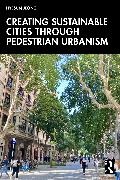Read more
As cities grapple with climate change and social inequality, a growing movement recognizes walking as fundamental to urban sustainability.
Creating Sustainable Cities Through Pedestrian Urbanism explores how communities worldwide are rethinking the relationship between mobility, place, and belonging.
Drawing from diverse cities across North America, Europe, and Asia, this book examines the shift from car-dominated planning toward human-centered design. It traces how walkable environments support environmental goals while fostering social connection and cultural vitality, demonstrating that sustainable cities are also more equitable and livable cities.
This book investigates varied examples: cultural programming in transit stations, night festivals and murals, pedestrian-friendly street transformations, adaptive public spaces, and community-led initiatives. It considers how everyday elements-café culture, green infrastructure, neighborhood events-contribute to places that are both environmentally responsible and socially cohesive.
Written for urban practitioners, community advocates, and engaged citizens, this book offers insights rather than prescriptions, recognizing that each place requires its own approach to pedestrian urbanism. By examining what works and what doesn't across different contexts and scales,
Creating Sustainable Cities Through Pedestrian Urbanism contributes to ongoing conversations about building cities that serve both people and planet. Sustainable urban futures, it suggests, may be closer than we walk.
List of contents
Introduction
1. Utopian Visions and Future Cities
2. Human-Scale and Multimodal Cities
3. Main Street as Everyday Urbanism
4. Café Urbanism: How Bohemian Culture Activates City Streets
5. Ecological Urbanism: Trails, Greenways, and Climate Resilience
6. Cultural Placemaking in Global Cities
Conclusion
About the author
Hyesun Jeong is an architect, urban designer, and researcher whose work explores the intersection of cultural placemaking, sustainable urbanism, and public space. She is Assistant Professor of Urban Design at the University of Cincinnati.
Summary
This book explores how communities worldwide are rethinking the relationship between mobility, place, and belonging. It traces how walkable environments support environmental goals while fostering social connection and cultural vitality, demonstrating that sustainable cities are also more equitable and livable cities.

